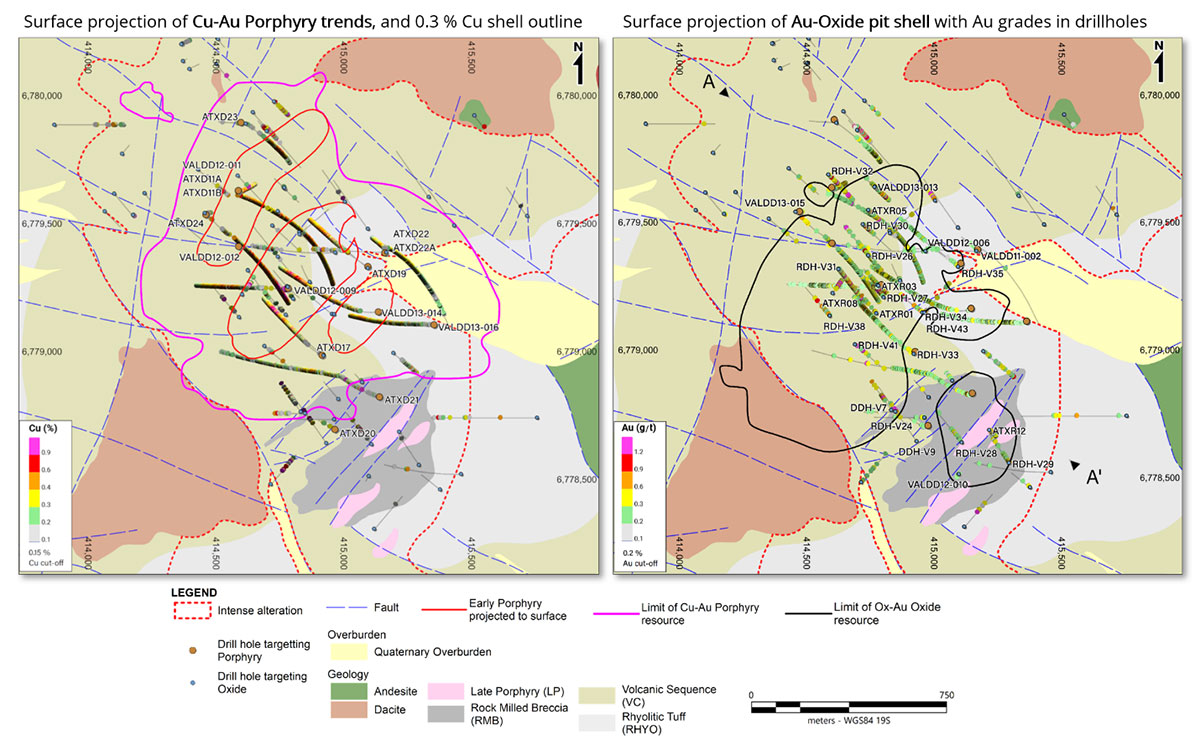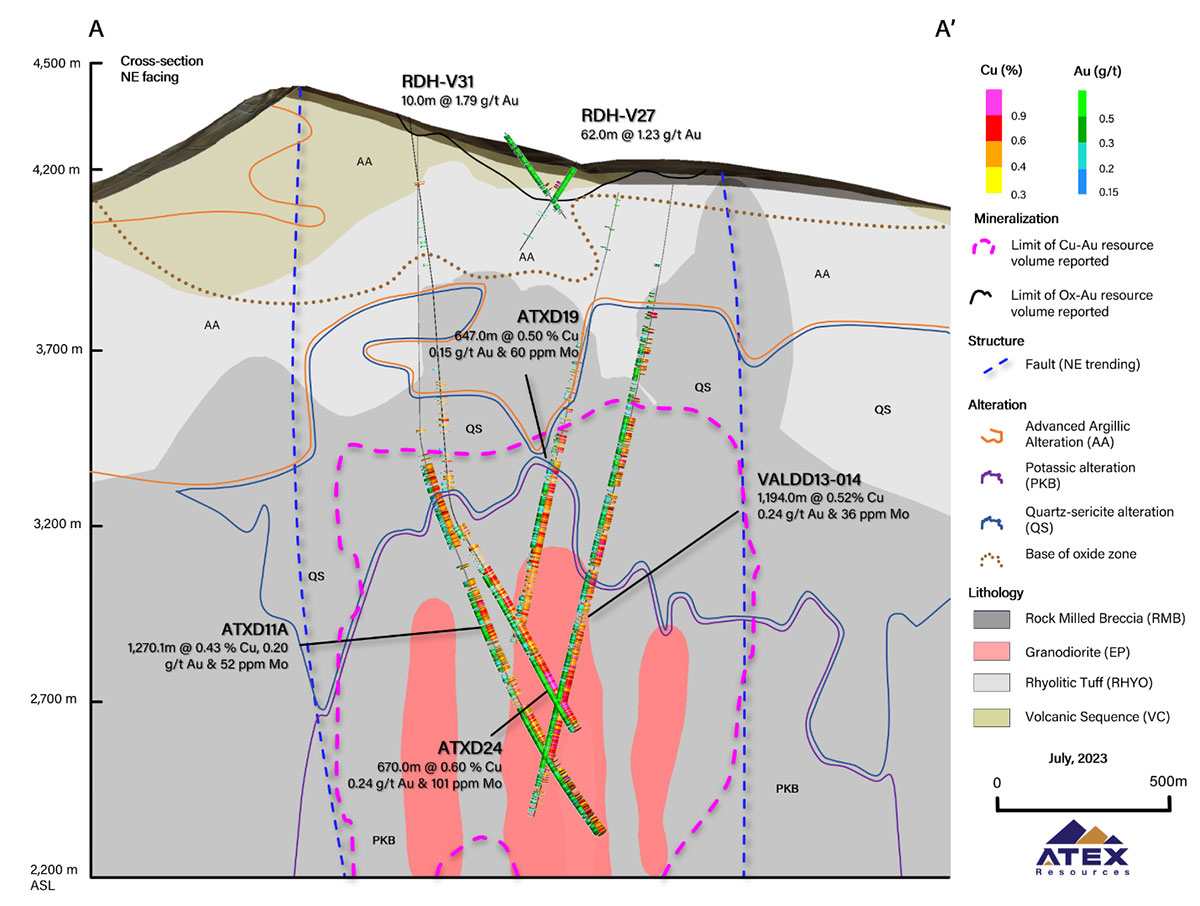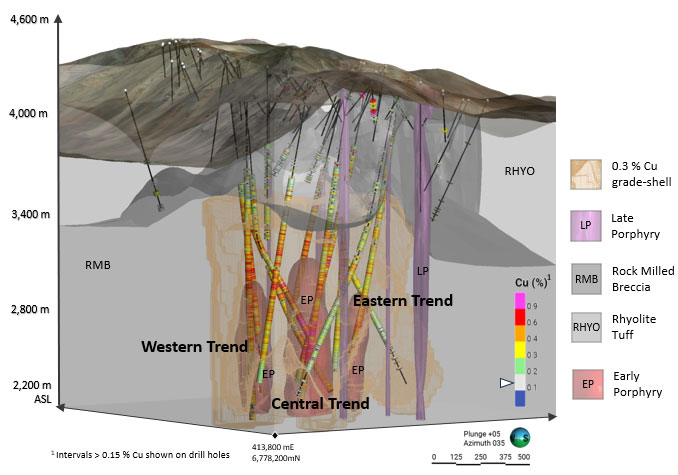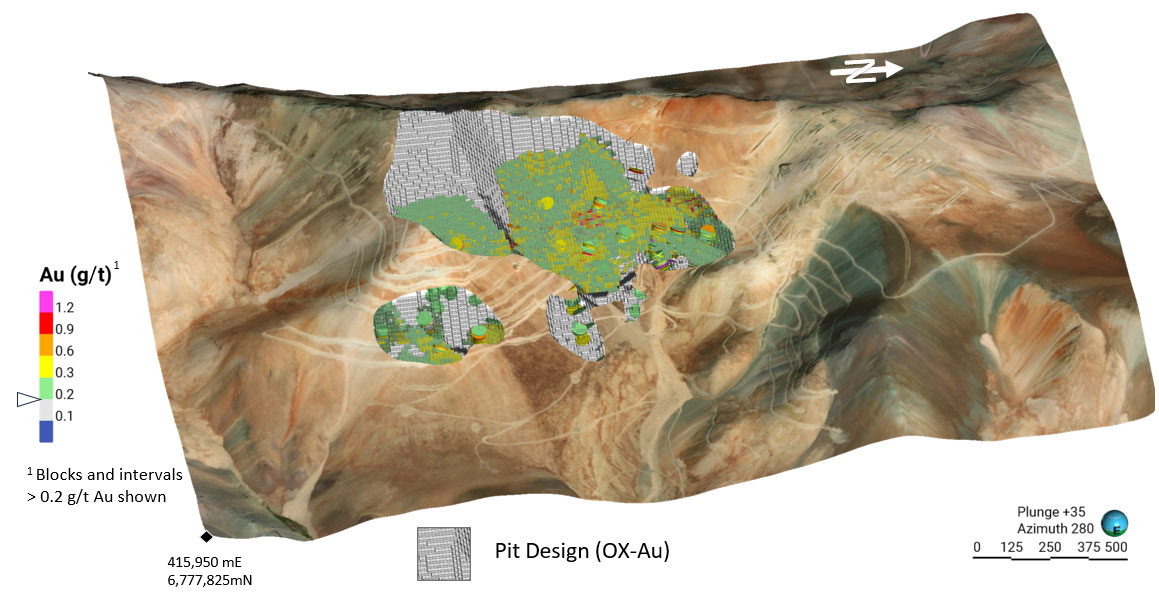I agree to and consent to receive news, updates, and other communications by way of commercial electronic messages (including email) from ATEX Resources. I understand I may withdraw consent at any time by clicking the unsubscribe link contained in all emails from ATEX Resources.
Table 1: Mineral Resource Statement*, Valeriano Project, Atacama Region, Chile. SRK Consulting (Chile) SpA., September 1, 2023
* Notes to accompany the Mineral Resource Estimate:
- The Independent and Qualified Person for the Mineral Resource Estimate, as defined by NI 43-101, is Joled Nur, CCCRRM-Chile of SRK Consulting (Chile) SpA, with an effective date 0f September 1, 2023.
- Mineral Resources are not mineral reserves and do not have demonstrated economic viability.
- Mineral Resources have been classified in accordance with the Canadian Institute of Mining, Metallurgy and Petroleum ("CIM") Definition Standards on Mineral Resources and Mineral Reserves 2019.
- Reasonable prospects of eventual economic extraction (“RPEEE”) were considered by applying appropriate cut-off grades and reporting within potentially mineable constraining shapes derived from benchmarked economic factors.
- Metal prices considered were US$1,800 /oz Au, US$3.15 /lb Cu, US$23 /oz Ag, and US$20.00 /lb Mo.
- Cut-off grades used for reporting were, 0.28 g/t Au for the Au-oxide and 0.40% Cu for the Cu-Au sulphide resource.
- Metallurgical recoveries assumed for Au-oxide mineralization are based on Coarse Bottle Roll and CIL leach test work and are 78.0% for Au and 50.0% for Ag.
- Metallurgical recoveries assumed for Cu-Au underground amenable sulphide mineralization are based on initial flotation test work and are 90.0% for Cu, 70.0% for Au, 80.0% for Ag, and 60% for Mo.
- Au-epithermal Mineral Resource estimates are reported within an optimized, conceptual, pit shell, with a pit slope angle of 45° and assuming US$2.35/t for mining costs, US$5.26/t for processing costs, and US$1.31/oz for sales costs.
- Cu-Au porphyry Mineral Resource Estimates are reported assuming bulk underground extraction techniques and 40 m x 40 m x 40 m panels with no internal selectivity within a potential mineable envelope constraining mineralization above 0.30% Cu.
- Tonnage is expressed in millions of tonnes; metal content is expressed in thousands of ounces, for gold and silver, millions of tonnes, for copper, and thousands of tonnes for molybdenum
- All figures rounded to reflect the relative accuracy of the estimates and totals may not add up due to rounding
- Copper Equivalent (CuEq) is calculated using the formula CuEq % = Cu % + (6481.488523 * Au g/t /10000) + (94.6503085864 * Ag g/t /10000) + (4.2328042328 * Mo g/t /10000)
- Gold Equivalent (AuEq) is calculated using the formula AuEq g/t = Au g/t + (0.00840643275 * Ag g/t)
ATEX Drilling
Drilling by ATEX commenced in 2021 and 18,029 metres of drilling has been completed by the Company to date over three phases (Figure 1).
Phase I drilling in 2021 targeted near surface oxide gold mineralization identified by previous operators and included 12 RC holes (ATXR01 through ATXR12) totaling 1,706.0 metres.
Phase II drilling in 2022 targeted the deeper-seated copper-gold porphyry style mineralization and included three drill holes totaling 3,809.7 metres. Phase II achieved proof of concept on the presence and continuity of a high-grade porphyry trend and was completed in the first half of 2022.
'Phase III drilling commenced in October 2022 and completed in May 2023 and included 8 diamond drill holes (four from surface and four daughter holes) totaling 12,513 metres with all holes intersecting significant Cu-Au porphyry related mineralization (Figure 3). The Phase III campaign was designed with the objectives of expanding the mineralized corridor through step out drilling along strike as well as exploring the continuity and geometry of the high-grade trend intersected in Phase II while looking to extend it along strike.
Figure 1: Surface Projections of Cu-Au Porphyry and Au-Oxide pit shell
Resource Estimation Methodology
The Mineral Resource estimation methodology used by the QP’s to update the Mineral Resource Estimates on the Valeriano Project included the following procedures:
- Compilation and verification of the updated database,
- Review of the component parts of the 3D geology model built by ATEX for mineralization, lithology and alteration,
- Definition of estimation domains based on exploratory data analysis in the modeled mineralization, lithology and alteration domains,
- Data conditioning (compositing and capping),
- Geostatistical analysis including Variography,
- Block modelling and density interpolation,
- Grade estimation,
- Resource classification,
- Assessment of the “reasonable prospects for eventual economic extraction” and selection of appropriate reporting cut-off grades,
- Preparation of a Mineral Resource Statement, and
- Reconciliation with the previous Mineral Resource estimate.
The mineralization, lithological and alteration domains were built by ATEX using implicit and explicit modelling techniques in LeapFrog™ software (see Figures 2, 3 & 4). Mineralized and discrete features were modelled with explicit inputs based on the informing datasets. The geostatistical Mineral Resource estimates were completed by SRK using Vulcan™ software.
In the opinion of the QP, the Mineral Resource evaluation reported herein is a reasonable representation of the global copper, gold, molybdenum, and silver mineralization of the Valeriano deposit at the current level of sampling. The Mineral Resources have been estimated in conformity with generally accepted CIM Estimation of Mineral Resources and Mineral Reserves Best Practices Guidelines (2019) and are reported in accordance with the Canadian Securities Administrators’ National Instrument 43-101. Mineral Resources are not Mineral Reserves and have not demonstrated economic viability. There is no certainty that all or any part of the Mineral Resources will be converted into Mineral Reserves.
Figure 2: Geology cross section through the Valeriano system showing lithology and alteration related to Mineralization
Figure 3: Valeriano Cu-Au Porphyry 3D Models – Isometric View looking ENE
Figure 4: Valeriano Au-Ox Epithermal Resource – Isometric View looking W
Qualified Persons
For further information, please see ATEX’s NI 43-101 compliant technical report titled “Independent Technical Report for the Valeriano Copper-Gold Project, Atacama Region, Chile” with an effective date of September 1, 2023, prepared for ATEX by SRK Consulting (Chile) SpA. A copy of the foregoing technical report is available on ATEX’s website and also under ATEX’s SEDAR+ profile at www.sedarplus.com. The New Technical Report supersede the Company’s technical report entitled "Valeriano Project, Inferred Resource Estimates, Atacama Region, Chile," with an effective date of November 13, 2020, in its entirety.
The Authors of this report are Qualified Persons (“QP’s”) as defined by National Instrument 43-101, Standards for Disclosure for Mineral Projects (“NI 43-101”). They are independent of ATEX, the vendors, and the Property.
The QPs, who are all independent of ATEX, are:
- Mr. David Hopper, who is a Chartered Geologist of the Geological Society of London, Fellow No.1030584. Mr. Hopper is responsible for sections 1, 2, 3, 4, 5, 6,7, 8, 9, 10, 11, 12, 19, 22, 23, 24, 25.Mr. Hopper is a resident of Santiago, Chile, and has over 33 years of relevant experience in exploration of porphyry-epithermal systems in a variety of geological environments.
- Mr. Joled Nur, Civil Mining Engineer, SRK Consulting (Chile) SpA who is a member of the Public Register of Competent Persons in Mining Resources and Reserves of Chile, No. 181. Mr. Nur is aresident of Santiago, Chile, and has over 23 years of relevant experience in mineral resource estimation in similar deposit styles and settings. Mr. Nur is responsible for section 13.The MRE’s, that are the subject of this report, have been prepared using the CIM Estimation of Mineral Resources & Mineral Reserves Best Practice Guidelines dated November 29th, 2019.
Additional contributions were provided by:
- Dr. David Machuca-Mory, PEng (PEO#100508889), a principal consultant of SRK Consulting(Canada) Inc. Dr Machuca-Mory contributed with the MREs validation and the Reasonable Prospects for Eventual Economic Extraction (RPEEE) for the underground scenario. Dr. Machuca-Mory provided senior review for section 13 and the Mineral Resource Statement of this technical report.
- Mr. Martin Cares, a mining engineering consultant of SRK Consulting (Chile) SpA. Mr. Cares contributed with the RPEEE for the open pit scenario.
Quality Assurance / Quality Control
ATEX
A routine quality assurance and quality control ("QAQC") programme has been implemented by ATEX to monitor on-going quality of the analytical database results. This programme is set out for all geologists in a standard operating procedure (“SOP”) document that outlines the rate of insertion per batch of control samples totalling 12% controls for in each 75-sample batch. Control samples (excluding blanks) are inserted randomly every 5 to 10 samples as defined and documented by the ATEX geology team. Blanks are inserted continuously within the sample stream with the fine blank material inserted preceding the coarse blank material. This process is undertaken at a third-party facility (“IMG”) located in Vallenar, close to the ATEX core facility. This process is managed and overseen by an ATEX team member and sample batches are manually verified against sample sheets before being shipped.
The QP is of the opinion that the processes and procedures used by ATEX for sample preparation, analysis and security are in line with industry best practice and nothing has been observed that would suggest bias, contamination, or other errors. The sample materials and assay results are adequate for use in modelling and estimation of Mineral Resources.
Historical operators
The diamond drilling core from Hochschild’s 2011 to 2013 drilling campaign were collected and sampled under the direct supervision of Hochschild’s staff. Diamond drill core was placed in core boxes at the drill site, appropriately tagged, secured and transported to the Hochschild’s exploration camp. Drill core was logged, marked, on average, at 2 metre intervals for sampling and split longitudinally with a diamond drill saw. One half of the core was bagged and sample tags attached and the second half of the core was returned to the core boxes. All samples were appropriately labelled and transported by truck by Hochschild personnel to the ALS Chemex laboratory located in Coquimbo, Chile. ALS Chemex-Coquimbo carried out preparation, chemical analyses and QA/QC. The preparation protocol (PREP-31B) consisted of crushing 70% to less than 2 mm (-10#), rotary split of 1 kg and pulverization to better than 85% passing 75 microns (-150#). Gold was analyzed via 50-gram fire assay and AA. Thirty-five additional elements, which included Cu, Ag, molybdenum and arsenic were assayed using aqua regia digestion and ICP-AES analysis (protocol ME-ICP41).
Hochschild’s QA/QC protocol for drill hole samples included field, coarse reject and pulp duplicates of samples, blanks, and Au and Cu standards. At least 20% of the samples were sent for assay comprised quality assurance duplicates, blanks and standards.
ATEX reviewed QA/QC data obtained during Hochschild’s 2011-2013 drilling campaigns. A total of 7,397 drillhole samples were collected in holes VALDD-01 through VALDD-16.
Overall conclusions drawn from the QA-QC analyses are as follows:
- Analyses of duplicates show good precision indicating that the protocols used for sample preparation and assaying were adequate.
- Analyses of standards used during exploration show good accuracy, however, one Au standard showed a consistent negative basis (-15.77%).
- Analyses of blanks showed no serious contamination problems between samples.
The overall conclusion is that the available QA-QC data generated by Hochschild for the Valeriano drill program meets acceptability criteria for the stage of the project and the exploration data can be used for modeling and estimation of inferred resources.
There is no QA/QC data available from the Phelps Dodge drilling program. From drill logs, it is apparent that diamond core was sampled based upon geological controls in areas of potential mineralization and was sampled and assayed at 1-metre intervals in areas of no apparent mineralization. Drill core recovery appears to have been good. The sampling protocol resulted in variable sample lengths in areas of interest typically from 10 to 50 centimeters. In the case of reserve circulation drill holes, sampling was completed at 1-metre intervals and the entire drill hole was sampled and assayed. There is no information available regarding the sample preparation or assaying methods used by Phelps Dodge.
There is no QA/QC data available and little sample or assaying methodology information available from the Barrick reverse circulation drilling program other than sampling was undertaken at 1-metre intervals and sampling commenced at the beginning of the drill holes.
Considering the seniority of the companies and the professionals involved at the time, there is no apparent reason to question the validity of the Phelps Dodge or Barrick assaying information. The assay results are internally consistent within the oxide resource area, geologically reasonable for the type of deposit and intensity of mineralization and are comparable to the assay results returned by Hochschild drilling in the same area. It is therefore considered reasonable that these results be included in the estimation of an inferred resource on an early-stage exploration property.
Details of historical exploration, including drilling, sampling and assaying, together with ATEX’s QA-QC analysis and commentary are available in the “Independent Technical Report for the Valeriano Copper-Gold Project, Atacama Region, Chile”, with an effective date of September 1, 2023, and available under the ATEX Resources SEDAR profile.NI 43-101 TECHNICAL REPORT ON THE VALERIANO PROJECT, ATACAMA REGION, CHILE” dated November 25, 2020 and filed at www.sedar.com
Table 2: Cu-Au Porphyry Mineral Resource Sensitivity Analysis*
| Cut-off Grade (Cu%) |
Contained | Grades | Contained Metal | |||||||
|---|---|---|---|---|---|---|---|---|---|---|
| Cu | Au | Ag | Mo | CuEq** | Cu | Au | CuEq | CuEq | ||
| (Mt) | tonnes | Ounces | tonnes | Lbs | ||||||
| (%) | (g/t) | (g/t) | (g/t) | (%) | (millions) | (000s) | (millions) | (billion) | ||
| 0.2 | 2,570 | 0.43 | 0.18 | 0.89 | 64.01 | 0.58 | 11 | 14,503 | 14.8 | 33 |
| 0.25 | 2,524 | 0.43 | 0.17 | 0.88 | 64.46 | 0.58 | 10.9 | 14,199 | 14.7 | 32 |
| 0.3 | 2,349 | 0.44 | 0.18 | 0.89 | 65.2 | 0.6 | 10.4 | 13,384 | 14.1 | 30.7 |
| 0.35 | 1,916 | 0.47 | 0.19 | 0.91 | 65.42 | 0.63 | 9 | 11,437 | 12.1 | 26.6 |
| 0.4 | 1,413 | 0.5 | 0.2 | 0.95 | 63.77 | 0.67 | 7.1 | 9,014 | 9.5 | 20.7 |
| 0.45 | 974 | 0.53 | 0.21 | 1 | 60.35 | 0.71 | 5.2 | 6,704 | 6.9 | 15.1 |
| 0.5 | 587 | 0.57 | 0.23 | 1.06 | 56.52 | 0.76 | 3.4 | 4,334 | 4.5 | 9.7 |
| 0.55 | 301 | 0.62 | 0.26 | 1.13 | 51.27 | 0.82 | 1.9 | 2,478 | 2.5 | 5.4 |
| 0.6 | 124 | 0.68 | 0.3 | 1.25 | 48.16 | 0.9 | 0.8 | 1,210 | 1.1 | 2.5 |
* The reader is cautioned that the figures in this table should not be misconstrued for a Mineral Resource Statement. The figures are only presented to show the sensitivity of the block model estimates to the selection of a cut-off grade.
** Copper Equivalent (CuEq) is calculated using the formula CuEq % = Cu % + (6481.488523 * Au g/t /10000) + (94.6503085864 * Ag g/t /10000) + (4.2328042328 * Mo g/t /10000)
Table 3: Au-Epithermal oxide Mineral Resource Sensitivity Analysis*
| Cut-off Grade (Au g/t) |
Quantity | Grade | Contained Metal | ||||
|---|---|---|---|---|---|---|---|
| tonnes | Au | Ag | AuEq** | Au | Ag | AuEq | |
| (millions) | (g/t) | (g/t) | g/t | Ounces | Ounces | Ounces | |
| 0.1 | 90.9 | 0.31 | 2.19 | 0.33 | 907 | 6,393 | 960 |
| 0.15 | 75 | 0.35 | 2.3 | 0.37 | 842 | 5,537 | 891 |
| 0.2 | 54.6 | 0.41 | 2.27 | 0.43 | 726 | 3,987 | 753 |
| 0.25 | 37.7 | 0.5 | 2.38 | 0.52 | 604 | 2,880 | 630 |
| 0.28 | 32.1 | 0.54 | 2.43 | 0.56 | 557 | 2,511 | 578 |
| 0.3 | 27.1 | 0.59 | 2.47 | 0.61 | 511 | 2,156 | 532 |
| 0.35 | 20 | 0.68 | 2.57 | 0.7 | 436 | 1,651 | 451 |
| 0.4 | 15.2 | 0.78 | 2.62 | 0.8 | 379 | 1,281 | 392 |
| 0.45 | 12.4 | 0.86 | 2.67 | 0.88 | 341 | 1,061 | 352 |
| 0.5 | 10.2 | 0.94 | 2.73 | 0.96 | 308 | 898 | 316 |
| 0.55 | 8.7 | 1.01 | 2.77 | 1.03 | 282 | 771 | 289 |
| 0.6 | 7.6 | 1.08 | 2.79 | 1.1 | 262 | 680 | 270 |
| 0.65 | 6.8 | 1.13 | 2.81 | 1.15 | 247 | 618 | 252 |
| 0.7 | 6 | 1.18 | 2.85 | 1.2 | 230 | 554 | 232 |
* The reader is cautioned that the figures in this table should not be misconstrued for a Mineral Resource Statement. The figures are only presented to show the sensitivity of the block model estimates to the selection of a cut-off grade
* Gold Equivalent (AuEq) is calculated using the formula AuEq g/t = Au g/t + (0.00840643275 * Ag g/t)
For further information, please see ATEX’s NI 43-101 compliant technical report titled “Independent Technical Report for the Valeriano Copper-Gold Project, Atacama Region, Chile” with an effective date of September 1, 2023, prepared for ATEX by SRK Consulting (Chile) SpA. A copy of the foregoing technical report is available on ATEX’s website and also under ATEX’s SEDAR+ profile at www.sedarplus.com.






